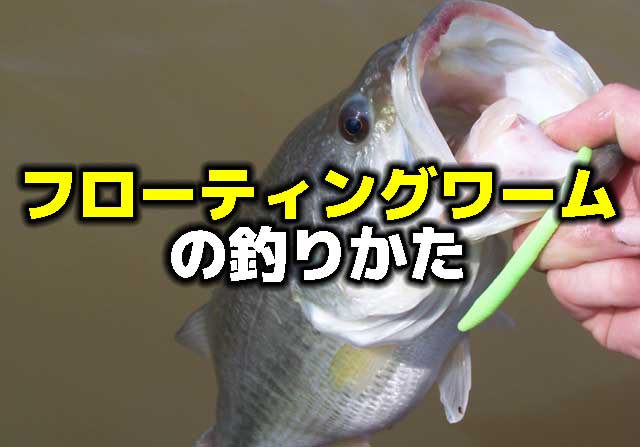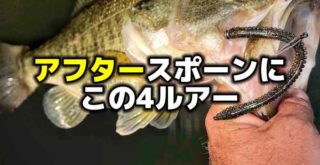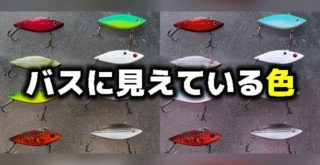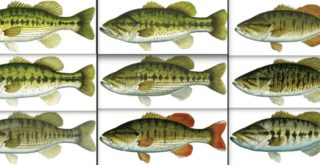初心者でもわかる!バス釣りにおけるラバージグの種類と使い分け
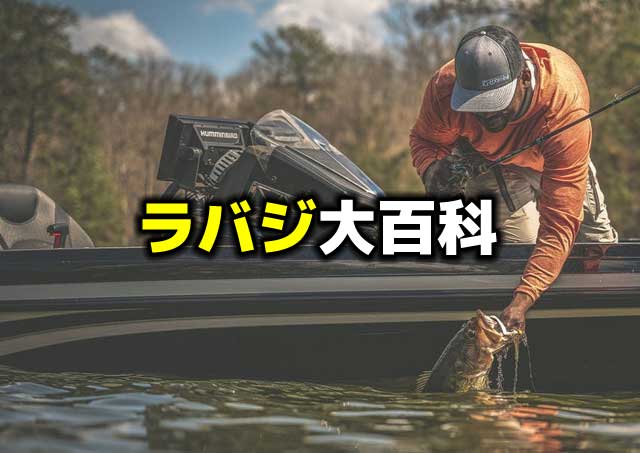
フットボールジグ、スイムジグ、フリッピングジグなど、バス釣りで使われるラバージグにはさまざまな種類があります。この記事では、人気のラバージグの特徴と釣り方をわかりやすく解説。バス釣り初心者の方でも使い分けのポイントがつかめます!ラバージグ選びに迷ったらこの記事を参考にしてくださいね。
こんにちは!店長の小山です!
バス釣りのタックルは近年ますます細分化、専門化が進んでいますよね。
今回のテーマ、ラバージグのカテゴリーでも同様です。
用途に合わせて素材やサイズや形状を変え、その用途に特化したものが増えていますよね。
しかし、何かに特化するというのは特定のバスに対しては有効な一方で、その特徴・使いどころなどをよく知っていないと使い物にならないものまであるという、諸刃の剣でもあります。
なかでもラバージグは、今日に至るまでひとつのカテゴリー内で多く枝分かれしてきた代表的なルアーなのではないでしょうか。
この記事は、アメリカのアウトドア専門ウェブマガジン「field and stream」のコラム記事で、ライターのシェイ・ベイカー氏が、細分化されたラバージグのなかから人気の6カテゴリーについて詳しく解説しています。
まだまだ6種では足りないと思うくらいですが、この6種のラバージグをより広く、深く理解することで、釣果は間違いなく上がるでしょう。
ぜひ最後まで読んでいってくださいね。
フットボールジグ
1. Football Jig One of the more easily identifiable jigs out there, the football jig has an oblong head that looks like—you guessed it—a football. These jigs are designed to be dragged slowly along a fairly clean bottom in deeper water. They’re primarily meant to mimic crawfish, and so the best color selections are darker, with a few strands of bright colors in the skirt, like orange. Since these baits are meant to be fished in more than 10 feet of water, the more popular sizes are in the 1/2- to 3/4-ounce range. How to Fish a Football Jig for Bass Football jigs work best when fish are out deep, which is the case primarily in the summer and winter. Cast a football jig out, let it sink the bottom, and then use slow drags to pull it in. If this doesn’t trigger a bite, fish can occasionally be caught by “stroking a jig”, which simply means snatching the bait up off the bottom a few feet and then letting it fall back down repeatedly. 2. Swim Jig Another easy bait to identify at first glance is a swim jig, easily distinguishable with a pointed nose so that it can swim through and over thick cover, like water willow, hydrilla, and other types of aquatic vegetation. These baits also work well around wood and docks. You can fish heavy swim jigs in deeper water, but the 3/8-ounce size typically works best in shallow water. And with the right color selection paired with the perfect soft plastic trailer, swim jigs can be used to imitate a wide variety of baitfish, from bluegills to perch to shad and more. How to Fish a Swim Jig for Bass Swim jigs work throughout the year, with spring being the standout. When bass are in the immediate pre- and post-spawn phases, they’ll collect in and around shallow cover. Cast a swim jig out and reel it in close to the surface through or over this cover while quickly twitching your rod tip. This is the most common way to fish a swim jig, but swimming the bait around cover that’s a little deeper works at times, too. 3. Flipping and Pitching Jigs These two jig styles could easily be broken into separate categories, but there are enough similarities to lump them together here. Flipping and pitching jigs are designed to fish shallow cover like brush, vegetation, and docks. While football jigs are meant to be drug along the bottom and swim jigs are more for swimming over top, flipping and pitching jigs are most effective in between, on the fall. How to Fish a Flipping-and-Pitching Jig for Bass These jigs are most effective in the spring and summer, as bass cling to isolated cover, like dock posts and stumps, and stage in stretches of submerged vegetation. Simply toss one of these baits near cover where you suppose a bass might be, and let the bait fall. If you don’t get bit on the initial descent, jig it up and down a few times as you bring it towards the boat, and then move on to the next bit of cover. 4. Finesse Jig Finesse jigs, otherwise known as ball-head jigs, typically come with a round head design. These baits often sport a spider-cut skirt, which means that the outside half of the jig skirt has been trimmed back to only a 1/2-inch or so. This does two things: it masks the head of the jig, making it look more like the tail of a crawfish, and it cuts the bulk of the skirt in half, creating a much smaller profile. A finesse jig is a great choice when the bass are out deep but not willing to bite a bigger football offering. How to Fish a Finesse Jig for Bass Finesse jigs work best when the water is cold. Throughout the winter and into the pre-spawn, these jigs can be drug along hard bottom for bass that are targeting crawfish and other bottom-dwelling bait. A simple slow drag works best, as you’re typically targeting lethargic bass in cold water with these jigs. 5. Skipping Jig Skipping jigs probably comprise the most niche of the types we’re covering here, but their specific design stands out enough that they warrant a stand-alone section. Skipping docks, pontoons, bushes, and other overhead cover is a great way to catch bass. And though most jigs can be skipped to some degree, skipping jigs are specifically designed for it. They have broad, flat heads, which create a lot of surface area to help the baits skip across the water. How to Fish a Skipping Jig for Bass Skipping jigs shine in the immediate pre- and post-spawn when bass are staging under docks, bushes, pontoon boats, and other overhead cover. In order to skip this bait across the surface, it’s best to use a side-arm roll cast, so that you can release the bait close to the surface. Think of skipping a rock across the surface of a pond, and then try to use your rod to do the same with your jig. The bass typically bite a skipping jig as soon as they see it, as they’ve positioned themselves near this cover to feed. 6. Casting Jig The last on our list is the casting jig. These are meant to be cast and dragged through cover, whether you’re fishing rocks or wood. The head design of most of these jigs has more of a scoop to it, with an upturned line-tie eye. This helps the bait be a little more snag-resistant compared to football jigs and finesse jigs, making a casting jig the perfect bait to be dragged across a clean bottom, through cover, or over cover, and then back across a clean bottom. How to Fish a Casting Jig for Bass Casting jigs work really well during the post-spawn, when bass start to pull offshore and collect in mid-range brush. Cast these jigs out past the cover and then drag them into the brush, keeping your rod tip high. As you start to feel the cover, slow your jig down and let it sit in the brush for a few seconds on fairly tight line. This will help you detect the bite and keep the bait from falling deep into the cover where you’ll run a higher risk of hanging up. Of course, that won’t be a worry if a big bass clobbers it.
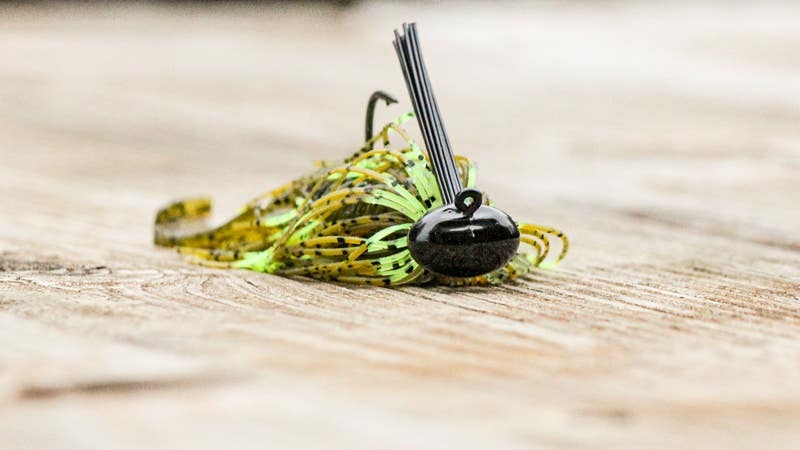
フットボールジグは、その独特な形からすぐに見分けがつきます。ヘッド部がアメリカンフットボールのような楕円形になっているのが特徴です。
このラバージグは、比較的きれいなボトムを這うように遅く引くことを意図して設計されています。主にザリガニを模しているので、暗めのカラーで、オレンジなどの明るい色を少し取り入れたスカートが最適でしょう。3メートル以上のディープで使用されることが多いため、人気のあるサイズは1/2オンスから3/4オンスくらいです。
フットボールジグのバス釣りの仕方
フットボールジグは、バスがディープにいる夏と冬に最も効果的です。ラバージグをロングキャストし、底まで沈めてからゆっくりと這うように引いていきます。これでバイトがない場合は、ラバージグをちょっと持ち上げてまた落とす「ストロークジグ」の方法を試してみるといいでしょう。
スイムジグ
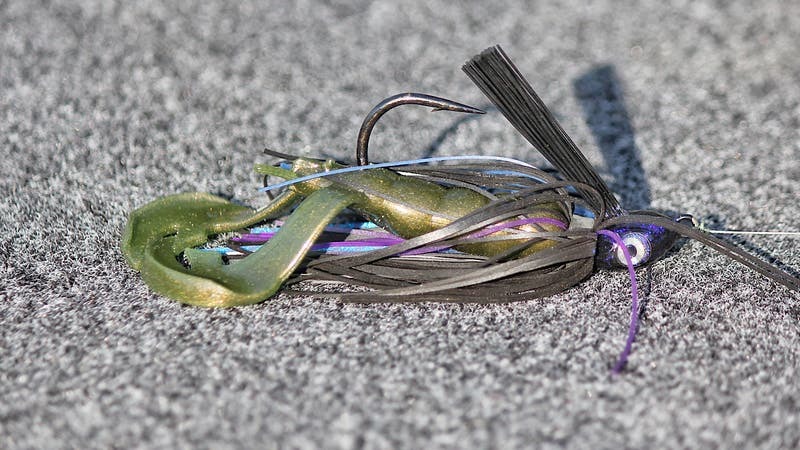
スイムジグも一目でわかる形をしています。先端が尖っているのが特徴で、水草や木の枝、桟橋などの濃いカバーの中をスムーズに泳がせることができます。
深場でも重めのスイムジグを使えますが、3/8オンスくらいのシャロー向きサイズが最も効果的です。適切なカラーのトレーラーを組み合わせることで、ブルーギルやパーチ、シャッドなど様々なベイトフィッシュを模倣することができます。
スイムジグのバス釣りの仕方
スイムジグは年中使えますが、特に春が最高のシーズンです。バスが産卵の直前・直後にシャローカバー周りに集まってくるので、その中を通したり、その上を通したりしながら、ロッドのティップを小刻みに動かしてリトリーブするのが一般的な釣り方です。もう少し深い場所のカバー周りで泳がせるのも時には効果的です。
フリッピングジグ・ピッチングジグ
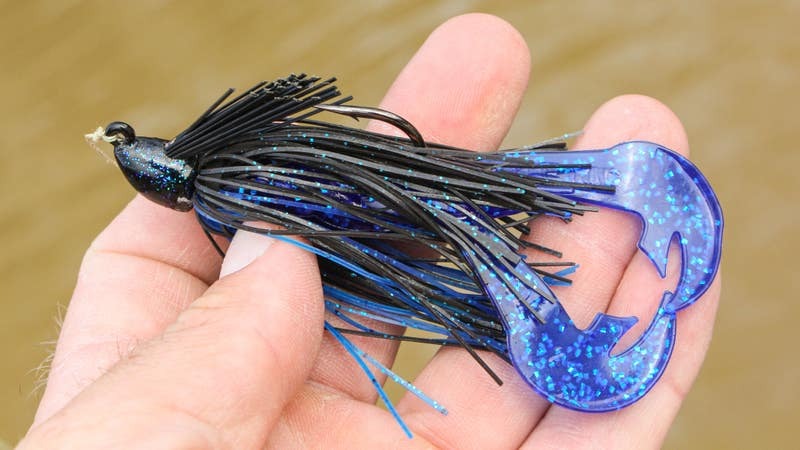
これら2種類のジグは、別々のカテゴリーに分けてもよいのですが、似た点が多いので一緒にまとめました。フリッピングジグとピッチングジグは、シャローのウッドカバーやウィード、桟橋などのカバーで釣ることを想定して設計されています。
フットボールジグが底を這うように引くのに対し、スイムジグはカバーの上を泳がせるのが主な用途ですが、フリッピングジグとピッチングジグはその中間、ラバージグのフォール中に最も効果を発揮します。
フリッピングジグ・ピッチングジグのバス釣りの仕方
これらのジグは春と夏に最も効果的です。バスが孤立したカバーの周りに潜んだり、ウィードの中で休んでいる時期です。
ラバージグをカバーの近くにキャストしたら、沈んでいくのを良く見ます。ファーストフォールでバイトがなければ、ラバージグを少し動かしてみて回収し、次のカバーに移動しましょう。
フィネスジグ
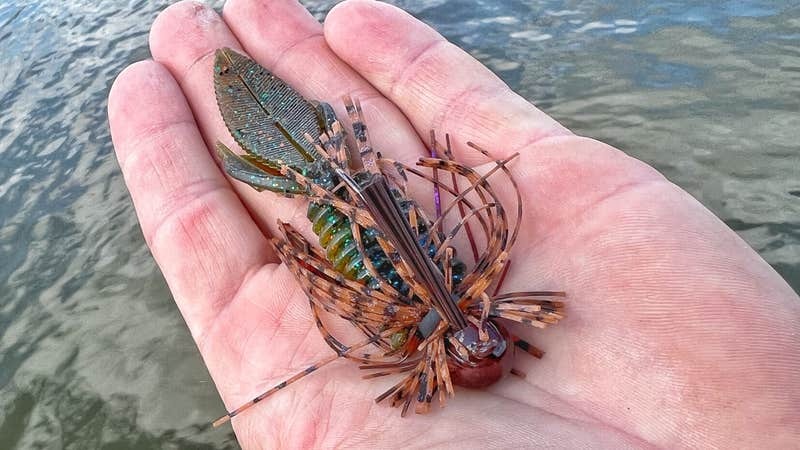
フィネスジグ、またの名をボールヘッドジグと呼びます。丸いヘッドが特徴的です。スカートはスパイダーカットと呼ばれる半分に切り取られた形状のことが多く、これによりヘッド部がザリガニの尻尾のように見え、スカートの量も半分以下に減らしてシルエットをスリム化しています。
フィネスジグは、バスがディープにいるものの、フットボールジグのようなフルサイズのラバージグには反応が鈍い時に適しています。
フィネスジグのバス釣りの仕方
フィネスジグは、冬に最も効果的です。冬から産卵期にかけて、ラバージグをゆっくりと底を這わせることで、ザリガニなどボトムにいるエサを狙うセレクティブなバスを狙えます。シンプルに底をゆっくりとズル引きするのがベストな釣り方でしょう。
スキッピングジグ
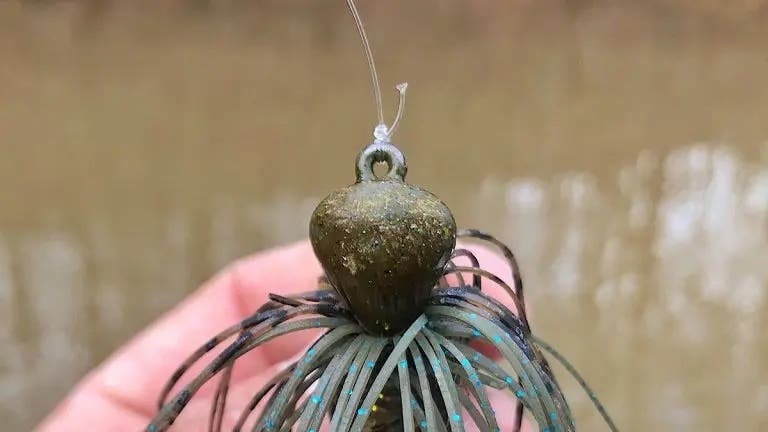
ここで紹介する種類の中では最もニッチな存在かもしれませんが、スキッピングジグの特殊な形状は一目でわかります。桟橋、フロート桟橋、木の枝の下などのオーバーハングをスキッピングして攻めるのは、バスを釣る上でとてもいい方法です。
ほとんどのラバージグはある程度はスキッピングが得意ですが、スキッピングジグはそのためだけに特化して設計されています。幅広くフラットな頭部があり、水面をよくスキップできるよう大きな面積を確保しています。
スキッピングジグのバス釣りの仕方
スキッピングジグが最も効果を発揮するのは、バスが桟橋やフロート桟橋、木の枝のオーバーハングの下に待機しているスポーニング直前・直後のシーズンです。
ラバージグを水面でうまくスキッピングさせるには、サイドハンドロールキャストを使い、水面近くでうまくリリースするのがコツです。池に平らな石を投げる水切りのイメージで、同じようにロッドを使ってラバージグを水面でスキップさせましょう。
カバーの下に待ち構えるバスは、スキッピングジグを見つけた途端に反応するはずです。
キャスティングジグ
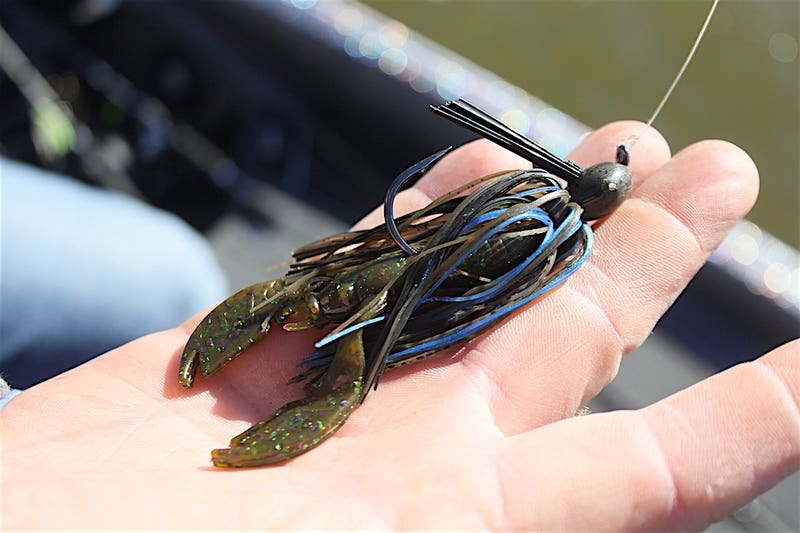
最後に紹介するのがキャスティングジグです。これはキャスト重視で設計されており、岩場やウッドカバーの中を釣ることを想定しています。ヘッド部は平べったいスコップのような形状で、ラインアイが上を向いているのが特徴です。
これにより、フットボールジグやフィネスジグに比べて根がかりにくく、底を這いながらカバーの中や上を通しやすくなっています。
キャスティングジグのバス釣りの仕方
キャスティングジグは、バスが産卵を終えて沖の方に移動し、ミッドレンジのウッドカバー周りに群がる時期に効果的です。
カバーの向こうへキャストし、ロッドティップを高く保ちながらカバーの中へ入れていくようにします。
カバーに当たったら、スピードを遅くしてラインテンションを締めて、ラバージグを数秒間、カバーの中に留めておきます。これにより、バイトに気づきやすくなり、ラバージグがカバーの中で根掛かりするリスクも下がります。もちろん、でかいバスにガツンと食われれば、根掛かりの心配もないのですけどね。
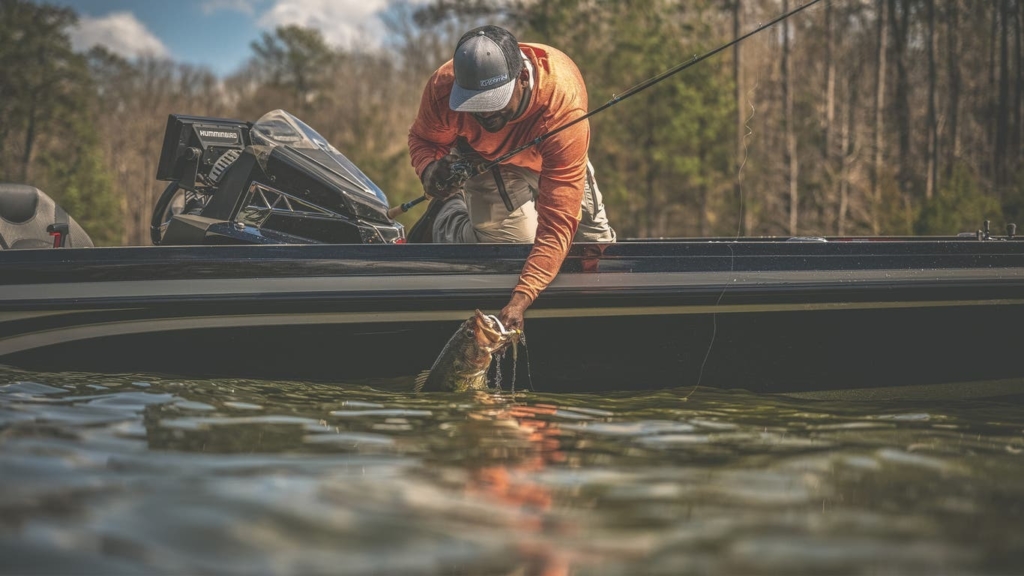
ラバージグの種類について、新たな発見はありましたでしょうか。
よほど適当に作られたものでもない限り、ルアーの形や重さにはすべて意味があると思います。
ラバージグでは特にラインアイの向きや長さ、フックシャンクの長さやゲイプの広さなど、パッと見では分かりにくい細かな違いが、最終的には大きな違いに現れるのではないかと思います。
ラバージグを手に入れた際は、開発者さんの意図を調べたりして、なぜこのルアーが必要なのかというところを深く探ることで、そのルアーの性能を最大限に引き出すことができ、それは当然、釣果につながることでしょう。
また、ここに書かれていることはあくまでも基本的な解説で、あえて別の使い方をすることで新しい発見や釣果につながることがあるのがバス釣りの自由で楽しい部分でもあると思います。
これからも細分化の流れは色々なルアーで起きていくかと思いますが、型にしばられすぎず、釣果も求めながら自由に楽しむようにしましょうね!
それではまた。
毎度ありがとうございます!
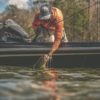
 https://www.fieldandstream.com/fishing/jig-fishing-for-bass/
https://www.fieldandstream.com/fishing/jig-fishing-for-bass/





